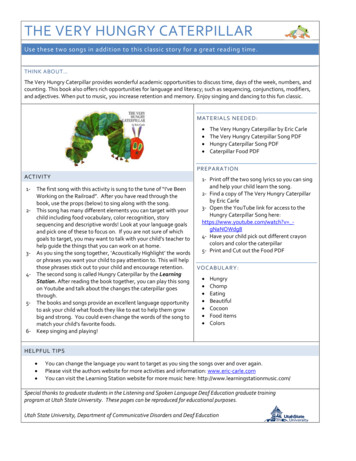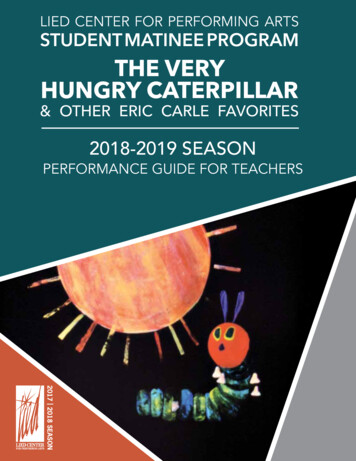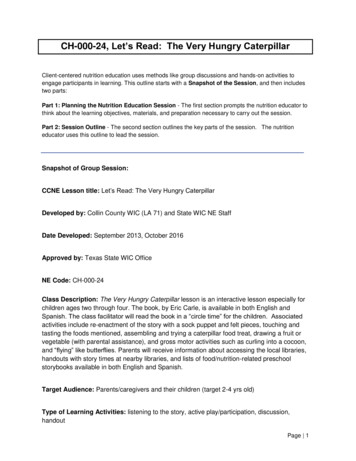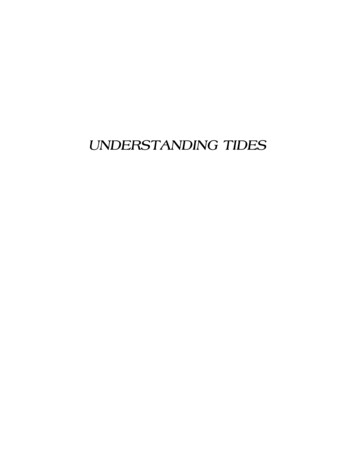
Transcription
EUROPEAN ACADEMIC RESEARCHVol. III, Issue 1/ April 2015ISSN 2286-4822www.euacademic.orgImpact Factor: 3.4546 (UIF)DRJI Value: 5.9 (B )The Hungry Tide: Amitav Ghosh’s Heart of DarknessINDRAJIT MUKHERJEE1Set in the Sundarban, the vast, intermittently submergedarchipelago, a UNESCO World Heritage, “am inconsequentialpiece of land in the political or economic calculus of the nationstate of India” (2009: 55), Amitav Ghosh‟s magnum opus TheHungry Tide (2004), a Bengali work of fiction in terms of ethos,temperament and the telling of the story according to theBengali novelist Sunil Gangopadhyay, addresses the aftermathof the 1947 partition in Bengal and looks at the suppressedhistory of the desperately poor and wretched refugees ofMorichjhapi who were butchered and battered on the thresholdof their undone years by the fascist C.P.I.M. Government ofWest Bengal in 1979 that it led to, thus highlighting one of themost vexed and long- standing unresolved issues of the complexpost-Independence subcontinental politics. Hindu myth has itthat the mighty river goddess Ganges frees herself from thetaming dreadlocks of Shiva --- the god of “destroyer andpreserver” (to borrow a Shelleyan phrase) --- near the Bay ofBengal in meandering strands, to create the Sundarbans, animmense stretch of mangrove forest, which forms the waterylabyrinth of islets in the delta of the Ganges as it debouchesinto the the Bay of Bengal, an eerie place where fantasy and1Indrajit Mukherjee (UGC NET) has completed his Graduation and thenwent on to complete his post Graduation from Rabindra Bharati University.He has been awarded with a Gold Medal for his academic excellence in Hons.and M.A (first class first in both). His areas of interest are PostcolonialLiterature, Modern Literary Theory, Avant-Garde Theater and CulturalStudies. He is currently teaching in a Govt. High School in West Bengal.774
Indrajit Mukherjee- The Hungry Tide: Amitav Ghosh’s Heart of Darknessreality constantly overlap: “At no moment can human beingshave any doubt of the terrain‟s utter hostility to their presence;of its cunning and resourcefulness, of its determination todestroy or expel them” (2004: 7). Here tigers, sharks, snakesand crocodiles kill dozens of people in the embrace of that densefoliage per year, and violent cyclones often have hundreds ofthousands dead in their wake, as occurred in 23rd May, 2009 inthe form of the horrendous storm called “Cyclone Aila”. Thus,The Hungry Tide, which has been described as “ a broaderecological agenda i.e. sensitive to the symbolic codepency of thehuman and nonhuman creatures that inhabit the particularbiospace of the sundarbans” (2007:128), becomes a Conradianexpedition, and Forsterish collision between Westernassumptions and Indian reality, between the Occident and theOrient, which throws in some Indiana Jones- style encounterswith tigers and crocodiles on board the Dunn and DuffyCombined Circus train in Utah in 1912.To this land discovered by the ebb-tide, bhatir desh, asGhosh calls it in a remarkable and poetic application of termused in Mughal land - records, come Calcutta-born tenaciousmarine biologist from the U.S. on the trail of a breed offreshwater dolphin, the Irrawaddy or Orcaella brevirostrisfluminalis, and a Delhi businessman who fancies himself abovebeing charmed, a middle-aged linguist who runs a translationbureau in the Capital of India, “my mind was full of poetry. Atthe start of my career, I wanted to translate Jibanabanda intoArabic and Adonis into Bangla” (2004:199). On Choosing theOrcaella as a research object draws her to her ancestral home,where she realizes she has “no more idea of what her own placewas in the great scheme of things (2006: 152). We areintroduced to Kanai Dutt at a south Kolkata commuter trainstation (Dhakuria), observing the “exotic” “foreign” Piyali Royand waiting to board a local train to Canning, a ghastly porttown once abandoned by the British (named after LordCanning), “the only rail connection to the Sundarbans” (2004:4). Her journey begins with a disaster: Piyali jumps off theEUROPEAN ACADEMIC RESEARCH - Vol. III, Issue 1 / April 2015775
Indrajit Mukherjee- The Hungry Tide: Amitav Ghosh’s Heart of Darknessmotorboat she has hired into swirling, muddy waters to saveherself from two potential rapists; one a guard foisted on her bythe forest department and the other, owner- pilot of the boatshe has hired. She is saved by Fokir ( Bengali version of Faqir),a lonely, sensitive, illiterate yet proud boatman, the “indigenouscanny” according to Pramod K. Nayar (2010:112), married toMoyna, a subaltern woman who wants to be a nurse. WhenPiyali needs a translator to connect with the local folk who willhelp her locate the dolphins she needs to study, Kanai isfortuitously available. As the three of them launch into theelaborate backwaters, they are drawn unawares into the hiddenundercurrents of this isolated world, where political turmoilsexact a personal toll i.e. every bit as powerful as the ravagingtide.Kanai goes off to the Hamilton Estates in Lusibari,where his aunt Nilima runs a hospital as a part of her NGOactivities. Nilima has lived in one of the islands for years; shesends for him after the discovery of a diary belonging to herlong- dead life-partner Nirmal, an idealist Marxist schoolteacher, would -be poet, and failed revolutionary, a prototype ofBalram of The Circle of Reason who was obsessed with Pasteurand phrenology, the carbon copy of the Muslim trader HossainMiya of Manik Bandopadhyay Padma Nadir Majhi who wantsto set up a little utopia on an island in the Padma delta, whosewithdrawal from political activism had brought them to settlein a village of Sundarban. As Kanai reads the diary, itsnarrative of past events, thoughts and feelings, hopes and fears,dreams and despair, frequent triumphs and infrequenttragedies, is interwoven with other stories, such as Kanai‟s ownmemories of a visit he paid his uncle and aunt as a child, hispresent experiences as a guest at Nilima‟s hospital, and Piya‟ssearch, aided by the subaltern fisherman Fokir, for theOrcaella. Through the diary, we get a picture of Nirmal, a“misplaced, misgendered Scheherazade . with a flying,fleeting pen” (2004: 148), a poet, fascinated with Rilke‟s mottoof life: “life is lived in transformation” (2004: 282). In his selfEUROPEAN ACADEMIC RESEARCH - Vol. III, Issue 1 / April 2015776
Indrajit Mukherjee- The Hungry Tide: Amitav Ghosh’s Heart of Darknessinflicted exile in Kusum‟s hut on the island of Morichjhapi, hehas nothing with him except his notebook and “a copy of aBangla translation of Rainer Maria Rilke‟s Duino Elegies - thetranslator, Buddhadeb Basu, was a poet he had once known”(2004:27). Rilke is important to Nirmal in another sense:Nirmal‟s notebook is a testimony of the events that take placeon the island of Morichjhapi (2012: 155). This is what postmodernist calls” intertextuality”, a phenomenon described as” ahyperawareness on the part of the text itself of its culturalreception” (1992:9). The term “intertextuality”, popularized inrecent decades, especially by Julia Kristeva (in 1966) amongothers, denotes the interdependence of any one literary textwith all those that have gone before it and therefore challengestraditional notions of literary influence, saying thatintertextuality denotes a transposition of one or several signsystems into another or others. In two essays, The Bounded textand Word, Dialogue and Novel, written in the late 1960s,Kristeva draws on the work of Bakhtin and the RussianFormalist Medvedev to propose the idea of “intertextuality”:“Any text is constructed as a mosaic of quotations; any text isthe absorption and transformation of another” (1986:37). ForRoland Barthes, “Any text is a new tissue of past citations. Bitsof code, formulae, rhythmic models, fragments of sociallanguages, etc, pass into the text and are redistributed withinit, for there is always language before and around the text.Intertextuality, the condition of any text whatsoever, cannot, ofcourse, be reduced to a problem of source or influences; theintertext is a general field of anonymous formulae whose origincan scarcely ever be located, of unconscious or automaticquotations, given without quotation marks” (1981:39). Foucaultalso underscores this process of automatic inter-lapping andoverlapping of various texts within a specific text: “Thefrontiers of a book are never clear-cut: beyond the title, itsautonomous form, it is caught up in system of references toother books, other texts, other sentences” (1972:23). BillAshcroft remarks that “the most compelling achievement ofEUROPEAN ACADEMIC RESEARCH - Vol. III, Issue 1 / April 2015777
Indrajit Mukherjee- The Hungry Tide: Amitav Ghosh’s Heart of Darknesstestimonio is its representation in the history of theunhistoricized, the „voiceless‟” (2001:113) and that “ a keyfunction of testimonio is the strategic attempt to controlrepresentation, to interpose a voice that has been silenced,oppressed or misrepresented, a goal which lies at the core of allinterpolating strategies” (2001: 114). Indeed, Nirmal regardshimself as a witness who must tell the story of Kusum and therefugees: “I remember that her voice changed as she wasrecounting her story; it assumed new rhythms and distinctivecadences My pen will have to race to keep up; she is themuse and I am just a scribe” (2004: 162).In The Hungry Tide, the theme of immigration,sometimes voluntary and sometimes forced, along with itsbitter or sweet experiences, runs through most incidents in thecore of the novel - the ruthless suppression and massacre ofEast Pakistani refugees in the forties and fifties who had runaway from the Dandakananya refugee camps to Morichjhapi asthey felt that the latter region would provide them withfamiliar environs and therefore a better life. In an interviewwith the Italian newspaper II Manifesto, Amitav Ghoshdeclares, “We know the world only in fragments and whatconcerns me about it is to explore the connections among peopleand their stories, to retrace the lost pieces from the mosaic. Inmy previous books, I had moved across different historical andgeographical landscapes, but the fact of choosing a morerestricted setting does not represent a limit, since a single placecan really contain a whole universe” (2012:105-106). At theheart of Nirmal‟s diary is the Morichjhapi massacre which, asan important illustration of the general tug-of- war betweenhuman rights and ecological preservation,” was backed by thebhadralok who perceived the refugees and the Sundarbansislanders as lesser beings who came behind tigers in theirclassificatory scheme of importance” (2005: 1759). Many, likethe girl Kusum in Ghosh‟s post-modern novel, Kanai‟schildhood playmate who becomes the repository of Nirmal‟sidealist hopes, were killed. Nirmal, a romantic, Bengali MarxistEUROPEAN ACADEMIC RESEARCH - Vol. III, Issue 1 / April 2015778
Indrajit Mukherjee- The Hungry Tide: Amitav Ghosh’s Heart of Darknessbeliever in a world where people can be “farmers in themorning, poets in the afternoon and carpenters in the evening”(2004:53), is later discovered wandering in the port town ofCanning; he is shattered by the event and never recovers. Asthe concluding significant expression of the trauma of Bengal‟sPartition, the story of Morichjhapi occupies a central place inthe novel. Nirmal‟s poignant response to the defiance of theMorichjhapi settlers in the face of government repressionresembles us Jethamoshai's words in The Shadow Lines: (1988)“I know everything, I understand everything. Once you startmoving you never stop. That‟s what I told my sons when theytook the trains. I said: I don‟t believe in this India-Shindia. It isall very well, you are going away now, but suppose when youget here they decide to draw another line somewhere? Whatwill you do then? Where will you move to? No one will have youanywhere. As for me, I was born here, and I will die here”(1988:215). Listening to those refugees crying out,“Amra Kara, bastuharaMorichjhapi chharbona”.(“Who are we? The homeless. We won‟t leave Morichjhapi.”),Nirmal says, “Where else could you belong, except in the placeyou refused to leave” (2004: 254).The friction between land and sea in the Sundarbans createsunique ecosystems for plant and animal life, and given theincreasing human encroachment on the habitat coupled withlopsided conservative initiatives, tensions between thesevarious elements seem inevitable. The number of people killedby the Royal Bengal tigers in the Indian Sundarbans tigerreserve has fluctuated between 66 in 1975-1976, 15 in 1989, 42in 1992 and 22 in 2002 according to the Carnivore PreservationTrust. When Fakir points out animal tracks in the mud that heclaims belong to a stalking tiger, Kanai assumes the fishermanshares his own instrumental view of knowledge as acommodity. When Kanai rejects Fakir‟s wisdom and the localEUROPEAN ACADEMIC RESEARCH - Vol. III, Issue 1 / April 2015779
Indrajit Mukherjee- The Hungry Tide: Amitav Ghosh’s Heart of Darknesssaying: ”that if you see a tiger, the chances are you won‟t live totell the tale” (2004: 242), Fakir leaves him alone on the island;only then does Kanai see himself as the ignorant outsider:“Fokir had brought him here not because he wanted him to die,but because he wanted him to be judged” (2004: 56).Thus, Fokirbelongs to the elusive band of initiates in Ghosh‟s oeuvreShambhu Debnath in The Circle of Reason (1986), Mangala inThe Calcutta Chromosome (1996) and Detti in Sea of Poppies(2008) --- who with their extra- sensory perceptions erodeEnlightenment‟s empirical rationalism (2014: 10). Withoutunderstanding the desperation of the villagers, Piyali Roy triesto single-handedly stop the villagers to the killing of a tiger thathad been causing havoc in a village and has to be dragged awayfrom the angry mob that burn a man-eating tiger to death byFokir and Horen, Naskar though, however, Piyali Roy isdevastated and their blissful communion is broken. Hawleycomments: “She is reminiscent of May Price in the face of theDhaka mob in The Shadow Lines, and like May, she is obviousto the danger in which she is putting everyone by romanticallystanding before a „force of nature‟” (2005:139). The tiger trappedand killed by villagers (especially by the tiger killing Kusum‟sfather) in the cowshed plunging their staves into the pen,setting fire to it, and “screaming in a maddened blood lust,Maar Maar!” (2004:95) and the dolphins killed by the coastguard‟s boar are counterpoised to underscore the plight of thenonhuman world of the Sundarbans (2008: 33). Kanai reasonsthe uncertain numbers and unpublicized death toll of humanskilled by tigers is because “these people are too poor to matter.We all know it but we choose not to see it. Isn‟t that a horrortoo---that we can feel the suffering of an animal, but not ofhuman beings?” (2004: 300-301) which resembles us theMarxist leader Radhika Ranjan Pramanik‟s words, “Tigers arethe best conservators of the forest. They keep human beingsaway. If there are no tigers in the Sundarbans, the forest areawould be left bare in months” (2008: 34-35). This relationbetween man and animals in The Hungry Tide reminds YotiEUROPEAN ACADEMIC RESEARCH - Vol. III, Issue 1 / April 2015780
Indrajit Mukherjee- The Hungry Tide: Amitav Ghosh’s Heart of DarknessDas‟s interest in birds and the analogy between the migratingbirds and the migrating characters in The Circle of Reason, thetale of a young weaver, who attempts to recover a continuingtradition of the interweaving cultures from his village in Bengalto the Gulf states and North Africa.Different ghosts emerge from the islands‟ past and theyare the product of those passages of people and cultures in thecourse of time: “Every generation creates its own population ofghosts” (2004: 50). One of the most surprising legacies of suchcontamination is the survival of an ancient ritual in theworshipping of the protecting mythical tiger goddess of the tidecountry, Bon Bibi, whose legend, The Glory of Bon Bibi,involves a strange mixture of Islamic mantras in the form of ahindu puja, representing the hybridity of the tide country. “Theimportance of hybridity is not to be able to trace two originalmoments from which the third emerges, rather hybridity to meis the „third space‟ “(1990:211), where, as Edward Sojaillustrates,”. everything comes together . subjectivity andobjectivity . the real and the imagined, the knowable and theunimaginable . mind and body, consciousness andunconsciousness, the disciplined and the transdisciplinary,everyday life and mending history.” It starts from Medina, “oneof the holiest places in Islam” (2004: 103), and travels fromArabia to “the country of eighteen tides (2004: 103), where thetwins Bon Bibi and Shah Jongoli conquer the demon king,Dokkhin Rai, and “decided that one half of the tide countrywould remain a wilderness . the rest . was soon made safefor human settlement” (2004: 103) and she becomes in thelegend “the saviour of the week and a mother of mercy to thepoor” (2004: 104) for everyone living in the tide country andpeople still call on her when they are in danger. This kind ofsyncretism is an extraordinary example of the stories that flowacross borders and arbitrary divisions, since there was a time,as also Ghosh illustrated in In an Antique Land (1992), wherecommunities of people in an Egyptian fellaheen village wouldexchange their cultural and popular knowledge for a betterEUROPEAN ACADEMIC RESEARCH - Vol. III, Issue 1 / April 2015781
Indrajit Mukherjee- The Hungry Tide: Amitav Ghosh’s Heart of Darknessunderstanding of each other. Horen tells this story of Bon Bibito Nirmal and reveals that the stories actually come from avery, very old book, written by a Muslim author Abdur Rahim,further Fokir learns it as a song from his mother, Kusum; andfinally Kanai translates it on paper for Piya (2012: 158):“Suddenly the language and the music were all around her,flowing like a river, and all of it made sense . Although thesound of the voice was Fokir‟s, the meaning was Kanai‟s and inthe depths of her heart she knew she would always be tornbetween the one and the other” (2004:360). The poetry of Rilkesings of a primal love (in the third elegy) that is Piya‟s forFokir‟s hymn of Bon Bibi:“Look, we don‟t love like flowersWith only one older than memory rises in our season behindus; when we love,A sap older than memory rises in our arms. O girl,It‟s like this: inside us we haven‟t loved just some oneIn the future, but a fermenting tribe; not just oneChild, but fathers, cradled inside us like ruinsOf mountains, the dry riverbedOf former mothers, yes, and all thatSoundless landscape, under its cloudedOr clear destiny - girl, all this came before you” (2004: 360).Piya tries to write the spatial history of the tide country: an actof psychological translation which trans-creates the time-spacecontinuum of the sundarbans into language that Pia knows.Piya‟s scientific expedition inevitably resembles us one of otherriver journeys: it mirrors Bernier‟s travels in India referred toin the novel, and it even has the classic moment of an encounterwith the “horror” (2004:300), when a tiger is killed in thedeepest jungle village (2012:161). Impressed against Marlow‟swill by Kurtz‟s intensity in Conrad's Heart of Darkness(1902),the intermediate narrator Marlow, who traces his first visit tocolonial Africa and his growing awareness of the evils, foundthat, back in Brussels, he could not tell the colonial intellectualKurtz‟s “Intended” the truth of his concluding words, “TheEUROPEAN ACADEMIC RESEARCH - Vol. III, Issue 1 / April 2015782
Indrajit Mukherjee- The Hungry Tide: Amitav Ghosh’s Heart of Darknesshorror! The horror (1988:68). It reminds us of the concludingstanza of Robert Southey‟s poem To Horror:“Horror! I call thee yet once more !Bear me to that accursed shore,Where on the stake the Negro writhes” (2004:47).The profound affinity and understanding between Fokir andPiyali is conveyed many times through a gift, a token, anoffering, unexpected and rare, offered in the exchange betweenequal human beings without expectations of return or reward.In the simple routine of living, washing and cooking, in theconfined space of the boat, floating in the endless universe ofthe sea, on the barest terms of survival, the contact andcommunication between them are on the purest terms ofhuman exchanges. This relationship rekindles in Piya herdeepest memories of her childhood that “were almost lost toher, those images of the past, and nowhere had she lessexpected to see them than on this boat” (2004:96): the touch ofher mother‟s sari, the smell of the kitchen at her house inSeattle, her father‟s attachment to a piece of old cloth,gamchha, a word she once knew but has now forgotten(2012:163). Fokir saves her life three times: once from drowningby instinct, as one human helping another, a complete strangerin the circumstance, once from a man-eating crocodile add thethird time when he willingly sacrifies his life for hers, out oflove, a pain and longing i.e. yet undefined and unnamed duringthe cyclone: “it was as if the storm had given them what lifecould not; it had fused them together and made them one”(2004:390). Piyali‟s journey reminds us of Ishmael‟s romanticdesire to experience a transcendent truth in the wild ofMelville‟s Moby Dick or The Whale (1851) which will remain afascinating hodge-podge of the “higgledy-piggledy wholestatements” (2007:54). Through this intriguing tale of history,folklore, ecology, migration, love and grief, the Sundarbans, likeConrad‟s Belgian Congo, becomes “the heart of an immensedarkness.” (1988:76).EUROPEAN ACADEMIC RESEARCH - Vol. III, Issue 1 / April 2015783
Indrajit Mukherjee- The Hungry Tide: Amitav Ghosh’s Heart of DarknessBIBLIOGRAPHY:Abram, H. M. A. Glossary of Literary Terms, (sixth Edition). U.S. A. : Harcourt Brace & Co., 1993.Anand, Divya. “Words on Water: Nature and Agency in AmitavGhosh‟s The Hungry Tide”. Concentric: Literary andCultural Studies. March 2008, Vol. 34(1): pp. 21-44.Ashcroft, Bill. Postcolonial Transformation. London: Routledge,2001.Barthes, R. „Theory of the Text‟. Untying the Text. Robert Young(Ed.) London : Routledge, 1981.Basu, Chitralekha. “Spotlight : Bengali: Novel in English”. TheStatesman 26 July. 2004.Bhabha, Homi K. “The Third Space.” Interview with JonathanRutherford. Identity: Community, Culture, Difference.Ed. Jonathan Rutherford. London: Lawrence andWishart, 1990.Bloom, Harold. Herman Melville’s Moby Dick. New Delhi: VivaBooks, 2007.Chakraborty, Nilanjan. “Myth, Politics and Ethnography inAmitav Ghosh‟s The Hungry Tide”. InternationalJournal of Humanities and Social Science Invention,February 2013, Vol. 2(2): pp. 24-28.Chatterjee, Partha. “Inadequacy of eraft”. The Hindu 4 July.2004.Collins, Jim. “Postmodernism and Television.” Channels ofDiscourse , Reassembled. Ed . Robert C. Allen. ChapelHill : University of North Carolina Press, 1992.Conrad, Joseph. Heart of Darkness. Robert Kimbrough Ed. NewYork: Norton, 1988.Dutta, Krishna, “ The Hungry Tide by Amitav Ghosh”. TheIndependent 11 June. 2004.Foucault, M. The Archeology of Knowledge. London : Tavistock,1972.Ghosh, Amitav. The Hungry Tide. London: Harper Collins,2004.EUROPEAN ACADEMIC RESEARCH - Vol. III, Issue 1 / April 2015784
Indrajit Mukherjee- The Hungry Tide: Amitav Ghosh’s Heart of DarknessGiles, Jana Maria. “Can the Sublime Be Postcolonial?Aesthetics Politics and Environment in Amitav Ghosh‟sThe Hungry Tide”. Cambridge journal of PostcolonialLiterary Inquiry, September 2014, Vol. 1 (2): pp. 223242.Hawley, Jonn C. Amitav Ghosh (CIWE - Contemporary IndianWriters in English). New Delhi: Foundation Books, 2005.Huttunen, Tuomas. The Ethics of Representation in the Fictionof Amitav Ghosh. Finland: University of Turku, 2011.Jalais, Annu. “Dwelling on Morichjhapi: When Tigers BecameCitizens, Refugees Tiger-Food”. Economic and PoliticalWeekly 23 April. 2005.Krishna, Arvind. A Concise History of Indian Literature inEnglish. Delhi: Permanent Black,2013.Kristeva, J. "Word, Dialog and Novel". ed. Toril Moi. TheKristeva Reader. New York: Columbia University Press,1986.Moore Gene M.Ed. Joseph conrad’s Heart of Darkness: ACasebook. New York: Oxford U.P., 2004.Nayar, Pramod K. English Writing and India, 1600-1920:Colonizing Aesthetics. London and New York: Routledge,2008.Roy,Rituparna.South Arian Partition Fiction in English FromKhushwant Singh to Amitav Ghosh. Amsterdam:Amsterdam U.P. , 2010.Soja, Edward. Thirdspace: Journeys to Los Angles and otherReal- and- Imagined Places. London: BlackwellPublishers,1996.Thieme, John. Post-Colonial Studies: The Essential Glossary.London: Arnold, 2003.Tomsky, Teri. “Amitav Ghosh‟s Anxious Witnessing and theEthics of Action in The Hungry Tide”. The Journal ofCommonwealth Literature,2009, Vol. 44(1): pp. ungrytide r.htmlEUROPEAN ACADEMIC RESEARCH - Vol. III, Issue 1 / April 2015785
Indrajit Mukherjee- The Hungry Tide: Amitav Ghosh’s Heart of Darknesshttp://en.wikipedia.org/wiki/The Hungry Tidehttps://en.wikipedia.org/wiki/Padma Nadir MajhiEUROPEAN ACADEMIC RESEARCH - Vol. III, Issue 1 / April 2015786
"Any text is constructed as a mosaic of quotations; any text is the absorption and transformation of another" (1986:37). For Roland Barthes, "Any text is a new tissue of past citations. Bits of code, formulae, rhythmic models, fragments of social languages, etc, pass into the text and are redistributed within










